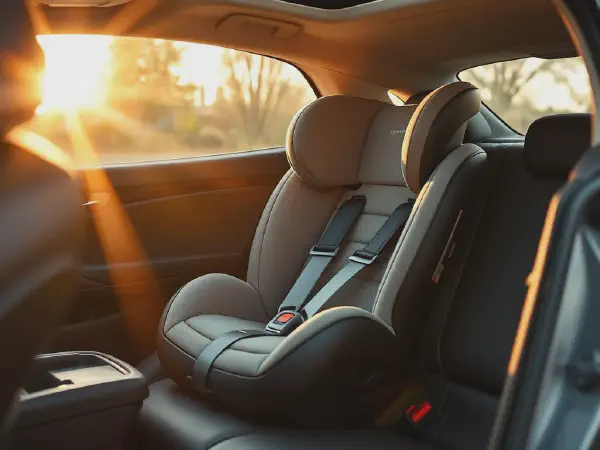The Ultimate Guide to Choosing the Best Convertible Car Seats

A Comprehensive Guide to Convertible Car Seats
Convertible car seats are designed to accommodate infants and toddlers as they grow, making them a popular choice among parents. These versatile car seats can be used in both rear-facing and forward-facing positions, offering flexibility and convenience. In this article, we will explore the features and benefits of convertible car seats, discuss the different types available, provide an installation guide, review top-rated options, and offer maintenance and cleaning tips. Whether you are a new parent or looking to upgrade your current car seat, this guide will help you make an informed decision.
One of the key features of convertible car seats is their ability to accommodate children as they transition from infancy to toddlerhood. This means that you can use the same car seat for a longer period of time, saving you money and eliminating the need to purchase multiple seats. Additionally, convertible car seats are designed with safety in mind, offering features such as side-impact protection, adjustable harness systems, and energy-absorbing foam. These safety features provide peace of mind for parents knowing that their child is protected in the event of a collision.
Aside from safety, convertible car seats also offer comfort features that ensure a pleasant riding experience for your child. These may include padded seat cushions, adjustable headrests, and reclining positions. Comfortable seating ensures that your child remains relaxed and content during car rides, reducing the chances of fussiness or discomfort.
For comprehensive reviews, check out Best Convertible Car Seats.
The versatility of convertible car seats is another major advantage. With the ability to switch between rear-facing and forward-facing positions, these seats can accommodate children of different ages and sizes. This versatility makes it convenient for parents who have multiple children or for those who want to use the same seat for different stages of their child's growth.
Another significant benefit of convertible car seats is their longevity. As your child grows, you can adjust the height and width of the harness to ensure a proper fit. Some convertible car seats even have extended weight and height limits, allowing them to accommodate children up to 65 pounds or more. This extended use makes convertible car seats a cost-effective option, especially considering that they can be used for several years.
Features and Benefits
Convertible car seats are packed with features and benefits that prioritize the safety of your child. They are equipped with various safety mechanisms, such as side-impact protection, which provides additional support and protection in the event of a collision.
Comfort is also a key aspect of convertible car seats. They come with padded cushions and adjustable headrests to ensure your child's comfort during long car rides. Some models even have additional comfort features, such as built-in cup holders or removable and washable seat covers.
Versatility is another advantage of convertible car seats. With the ability to switch between rear-facing and forward-facing positions, these seats can accommodate children of different ages and sizes. Some models can even be converted into a booster seat, further extending their usability.
The longevity of convertible car seats is a significant benefit. As your child grows, you can adjust the harness system to accommodate their height and weight. Some models have extended upper weight limits, allowing them to be used for several years.
Ease of use is also an important feature of convertible car seats. Many models come with an easy-to-use LATCH system that simplifies the installation process. They are also designed with clear and intuitive instructions, making it easy for parents to secure their child in the seat.
Types of Convertible Car Seats
Rear-facing convertible car seats are designed for infants and young toddlers. They provide a safe and secure rear-facing position to protect your child's head, neck, and spine in the event of a collision. Rear-facing seats typically have weight and height limits that can accommodate infants up to 40 pounds or more.
Forward-facing convertible car seats are suitable for older toddlers and young children. They can be used in a forward-facing position once your child has outgrown the rear-facing position. Forward-facing seats provide additional protection for your child's upper body and are designed to withstand frontal impacts. They typically have weight and height limits that can accommodate children up to 65 pounds or more.
3-in-1 convertible car seats are the most versatile option available. They can be used in three different configurations: rear-facing, forward-facing, and as a booster seat. These seats can accommodate infants, toddlers, and older children, making them a long-term investment for parents.
Installation Guide
The LATCH system is a popular installation method for convertible car seats. It uses lower anchors and tether anchors to secure the seat in place. To install a convertible car seat using the LATCH system, locate the lower anchors in your vehicle, attach the connectors from the car seat to the anchors, and tighten the straps until the seat is securely in place.
If your vehicle does not have a LATCH system, you can install the convertible car seat using the seat belt. To do this, thread the seat belt through the appropriate slots in the car seat, buckle the seat belt, and pull the seat belt tight to ensure a secure installation.
When installing a convertible car seat, it is important to follow the manufacturer's instructions carefully. This includes ensuring that the seat is installed at the correct angle, tightening the straps properly, and verifying that the seat is securely locked in place. Some common installation mistakes to avoid include not tightening the straps enough, using the wrong installation method, or installing the seat in the front seat with an active airbag.
Top-Rated Convertible Car Seats
Brand A is known for its high-quality convertible car seats. Their seats are equipped with advanced safety features and are tested for rigorous crash protection. They also prioritize comfort and usability, with features such as adjustable headrests and easy installation systems.
Brand B is a popular choice among parents for its affordability and reliability. Their convertible car seats meet all safety standards and offer a range of features to ensure the comfort and safety of your child. Additionally, they have a wide variety of designs and colors to choose from.
Brand C is well-known for its innovative and stylish convertible car seats. They combine safety and comfort with sleek designs that appeal to both parents and children. Their seats are made with high-quality materials and offer advanced safety features, ensuring your child's protection on every car ride.
Maintenance and Cleaning
Cleaning the seat cover is an important part of maintaining a convertible car seat. Most seat covers can be removed and washed according to the manufacturer's instructions. It is recommended to use a mild detergent and avoid bleach or harsh chemicals that could damage the fabric.
The straps of a convertible car seat can also get dirty and may need to be washed occasionally. Check the manufacturer's instructions for guidance on how to remove and wash the straps. It is important to let the straps air dry completely before reattaching them to the seat.
The base of the car seat should also be cleaned regularly. Use a damp cloth and mild detergent to wipe down the base, ensuring that all dirt and debris are removed. Be sure to thoroughly dry the base before reattaching it to the seat.
Tips for Choosing the Right Convertible Car Seat
When choosing a convertible car seat, consider your child's age and weight. Ensure that the seat you choose has weight and height limits that accommodate your child's current size and will provide a proper fit for years to come.
Check for safety certifications when selecting a convertible car seat. Look for seats that meet the federal safety standards and have been tested for side-impact protection. Additionally, consider seats that have been awarded safety certifications from independent organizations such as the National Highway Traffic Safety Administration.
Ease of installation is another important factor to consider. Look for seats that have an easy-to-use LATCH system or clear installation instructions. A seat that is difficult to install correctly may compromise the safety of your child.
Consider the compatibility of the convertible car seat with your vehicle. Check the manufacturer's guidelines to ensure that the seat will fit securely in your vehicle and that it is compatible with your vehicle's safety features, such as airbags.
